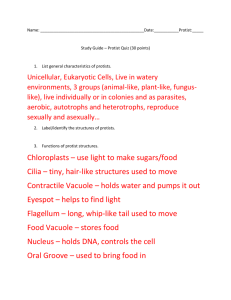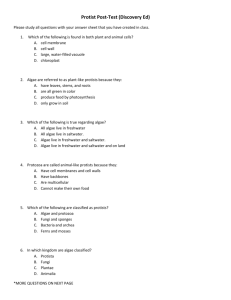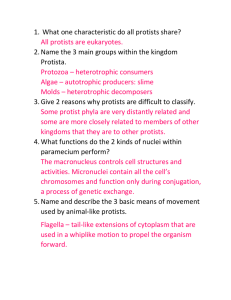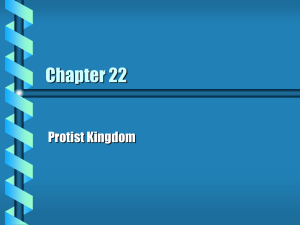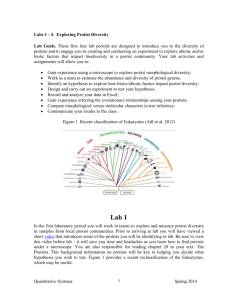Protists Packet (Ch. 3-1 and 3-1)
advertisement
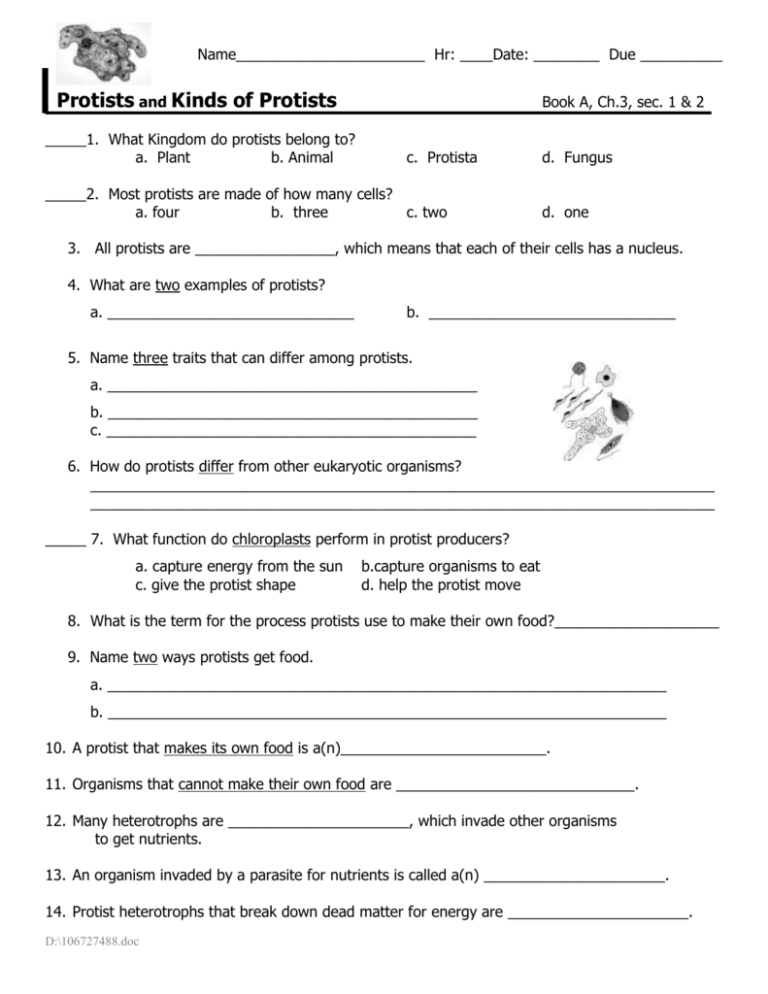
Name_______________________ Hr: ____Date: ________ Due __________ Protists and Kinds of Protists _____1. What Kingdom do protists belong to? a. Plant b. Animal Book A, Ch.3, sec. 1 & 2 c. Protista _____2. Most protists are made of how many cells? a. four b. three c. two d. Fungus d. one 3. All protists are _________________, which means that each of their cells has a nucleus. 4. What are two examples of protists? a. ______________________________ b. ______________________________ 5. Name three traits that can differ among protists. a. _____________________________________________ b. _____________________________________________ c. _____________________________________________ 6. How do protists differ from other eukaryotic organisms? ____________________________________________________________________________ ____________________________________________________________________________ _____ 7. What function do chloroplasts perform in protist producers? a. capture energy from the sun c. give the protist shape b.capture organisms to eat d. help the protist move 8. What is the term for the process protists use to make their own food?____________________ 9. Name two ways protists get food. a. ____________________________________________________________________ b. ____________________________________________________________________ 10. A protist that makes its own food is a(n)_________________________. 11. Organisms that cannot make their own food are _____________________________. 12. Many heterotrophs are ______________________, which invade other organisms to get nutrients. 13. An organism invaded by a parasite for nutrients is called a(n) ______________________. 14. Protist heterotrophs that break down dead matter for energy are ______________________. D:\106727488.doc 15. What do many protist heterotrophs eat? ____________________________________ Hetero – means other Troph- means eat 16. In what three ways do protist heterotrophs get food? a. ____________________________________________________________________ b. ____________________________________________________________________ c. ____________________________________________________________________ 17. Name one example of a parasite causing harm to its host. _______________________________________________________________________________ _________________________________________________________________________ _____18. In asexual reproduction, how many parents are there? a. one b. two c. three d. four _____19. In asexual reproduction, what process do single-celled protists use to divide into two cells? a. conjugation b. binary fission c. multiple fission d. single-cell fission _____20. What process do single-celled protists use in asexual reproduction to make more than two offspring from one parent? a. conjugation b. binary fission c. multiple fission d. single-cell fission Kinds of Protists _____21. What is the name for protists that convert the sun’s energy into food? a. slime molds b. algae c. amoebas d. parasites _____22. All types of algae have what color pigment? a. red b. blue c. brown d. green _____23. Where do most types of algae live? a. in dirt b. in water c. in sand d. in plants _____24. Which of the following is an alga that lives in shallow water along the shore? a. phytoplankton b. seaweed c. water mold d. radiolarian _____25. Which of the following provides most of the world’s oxygen? a. phytoplankton b. seaweed c. amoebas d. flagellates 26. Name four places where green algae live. ____________________________ ____________________________ ____________________________ ____________________________ D:\106727488.doc MATCHING _____27. the algae group most of the world’s seaweed belong to a. brown algae _____28. the protist producers that use photosynthesis to make food b. algae _____29. the main pigment in these algae cells is chlorophyll c. green algae _____30. the cell of this organism contains a glasslike substance called silica d. phytoplankton _____31. e. colony many individual protists living together as a group _____32. free-floating single-celled algae f. red algae _____33. seaweeds that live in cool climates g. diatoms 34. Individual cells of some green algae live in groups called _______________. 35. Where are diatoms found? _______________________________________ 36. The cell walls of diatoms contain __________________________. 37. The whip-like strands on a dinoflagellate that cause the cells to spin through water are called _________________________. 38. Where can amoebas be found?_________________________________ 39. What two things does an amoeba use pseudopodia for? a. ____________________________________________________________________ b. ____________________________________________________________________ 40. How is a food vacuole formed? ____________________________________________________ ______________________________________________________________________________ 41. What does the term mutualism mean? _______________________________________________ ____________________________________________________________________________ 42. - 43. What are the two uses for cilia? a. ____________________________________________________________________ b. ____________________________________________________________________ D:\106727488.doc MATCHING _____44. These are tiny, hairlike structures. a. cilia _____45. These have shells that look like glass ornaments. b. radiolarians _____46. This protist can live in the digestive tract of vertebrates. c. Giardia lambia _____47. This controls the functions of a ciliates cell. d. foraminiferans _____48. These have snail-like shells. e. macronucleus 49. Name two characteristics of spore-forming protists. a. ____________________________________________________________________ b. ____________________________________________________________________ 50. Slime molds use pseudopodia to eat bacteria and _____________________. 51. – 61. To help organize all this information, complete the table below. Term Definition 1.Parasite 2. 3.Consumer Example Giardia lamblia makes its own food, usually by photosynthesis slime mold 4.Flagella 5.Cilia 6.Pseudopodia amoeba 7.Spore-forming 62. The spread of malaria depends on both human and mosquito hosts. Use this fact to think of a way to stop the spread of malaria. ______________________________________________ __________________________________________________________________________ ____________________________________________________________________________ ________________________________________________________________________ D:\106727488.doc

